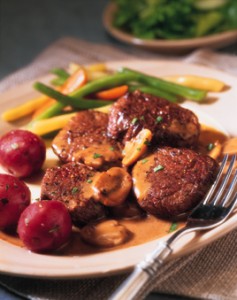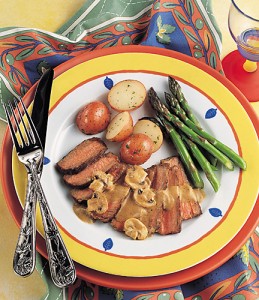Steak Diane is the classic sauté with pan sauce for carnivores who prefer flair in their meal presentation—and enjoy a bit of flare with their tableside preparation.
On the U.S.front in post-WWII days, casseroles, croquettes, creamed vegetables, chiffon pies, TV dinners, anything you could wrap in bacon, drive-ins, and an expanding range of modern boxed, canned, and frozen convenience foods prevailed in the marketplace and on home dinner tables. GIs returning from European and Asian war fronts brought with them a new-found appetite for ethnic foods, albeit considerably dumbed-down in many cases so as not to offend previously cloistered, yet newly experimental, American palates.
And beef was king!

Drama and Romance
Steak Diane is among those popular dishes in ubiquitous cosmopolitan, Continental-style restaurants of the 1950s and ’60s that combined high style with leather banquettes, white-linen table cloths and dishes of American and European influences, a bit of theater and dramatic preparation. Caesar salad, guacamole, and spaghetti carbonara, among others—all blended and cooked right before your eyes. French-inspired cherries jubilee, crêpes Suzette, and duck à l’orange, as well as the Creole classic, Bananas Foster, all featured a blast of tableside pyrotechnics.
Steak Diane shared the showcase of a dramatic flambé that was dosed and doused in a frying pan on a portable burner, atop a rolling cart. In a crowded restaurant, heads would snap to attention and eyes would focus sharply each time a waiter set the dish afire, shooting flames skyward. The puff, the pop, and the sudden brilliance of the mini-explosion never failed to ignite also the oohs and ahhs of nearby patrons.
“The beef, sizzling in a large copper pan with brandy flaming and cause bubbling, makes a wonderful show reminiscent of the days when Humphrey Bogart and friends would bound in at midnight following the newest opening on Broadway…“
— Jean Anderson, American Century Cookbook: The Most Popular Recipes of the 20th Century
If you’ve never eaten Steak Diane, remedy that situation as soon as possible by making this luxurious dish of sautéed filet mignon combined with a cream-and-butter sauce studded with shallots and laced with Cognac or brandy in your very own kitchen. (One thing to keep in mind is your level of comfort with flaming a hot frying pan. If you are not comfortable flambeing the steak, don’t do it. Just eliminate that step from your preparation.)
This is an ideal dinner for two—romantically luxurious and indulgent. Put a reminder in your calendar to make this dish next Valentine’s Day—and watch the sparks fly!
Ancient History
The recipe was named in honor of Diana, the Greco-Roman goddess of the hunt and the moon. Nemoralia, also known as the Festival of Torches, honoring Diana are celebrated all over Italy on August 13.
Throughout history, Diana has been portrayed in marble and on canvas frequently with a stag somewhere in the depiction. It recalls Diana’s using her deific powers to turn a hunter into a stag after he spied on her bathing in the wilderness.
So it’s not surprising that, in its original form, Steak Diane was a preparation of venison. In the late 1800s, the dish’s sauce was so popular it was paired with other selections, such as poultry and veal. As such, a la Diane dishes started springing up on menus everywhere. As time has passed, filet mignon has become the meat most closely identified with this dish, although you can find versions that use strip steak or sirloin.

The Origins
As with so many classic dishes and recipes, first-occurrence attributions or published reports to establish the exact origin of Steak Diane are challenged by several claimants.
It’s a complicated history that involves kissing cousin, steak au poivre, and can be traced as far back as the 1880s. The major difference is that steak au poivre calls for cracked peppercorns pressed into the steak to form a crust and more peppercorns are incorporated into the sauce.
However, there is a thread of agreement that the dish became trendy in New York City restaurants in the ’50s and ’60s.
The first documented recipe for Diane sauce came from the master himself, Auguste Escoffier, in 1907. In that version, Escoffier pushes the envelope of decadence even farther by fortifying the rich sauce with shaved truffles and hard-cooked eggs.
The dish’s popularity in this country, and others like it, coincided with Julia Child’s earliest forays into teaching average Americans how to demystify French cuisine at home.
The Recipe
Recipes for Steak Diane abound, each with their own peculiarity—just type “Steak Diane recipe” into a search engine and choose the variation that best suits your style. As an alternative to sautéing the filets, you could grill them and make the sauce sans pan juices.
The basic recipe is to butterfly two 6- to 8-ounce filets mignon. Saute in butter and then remove. Add shallots and then deglaze the pan with Cognac or brandy. Ignite and, when the flames die down, add in some beef stock or veal demi-glace, heavy cream, and a generous amount of pepper; simmer to reduce and thicken the sauce until it coats the back of the spoon.
Have you ever enjoyed this Culinary Classic? Where did you have the best Steak Diane you’ve ever had? Have you ever made it yourself? Are you brave enough to flambé or not?



Leave Your Response